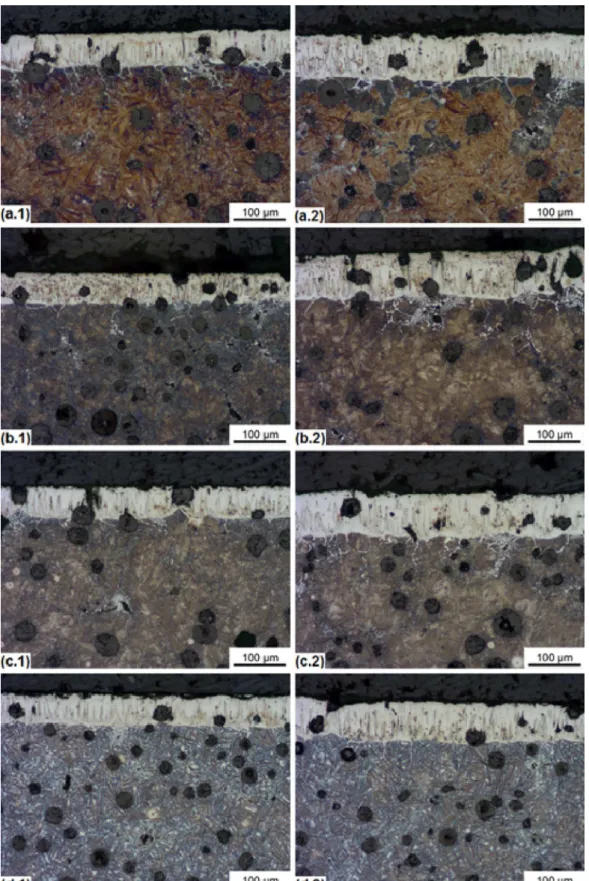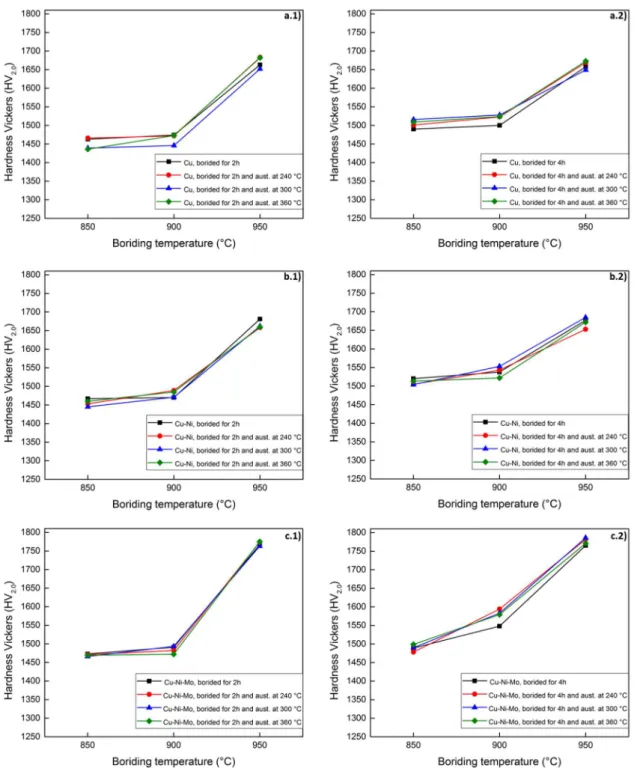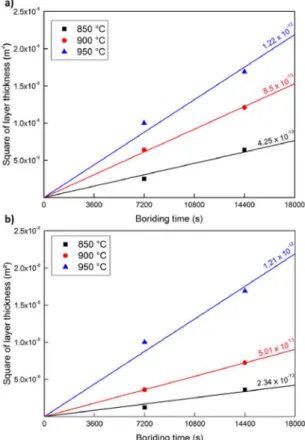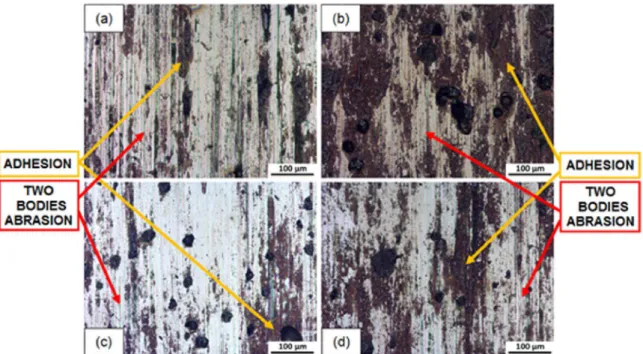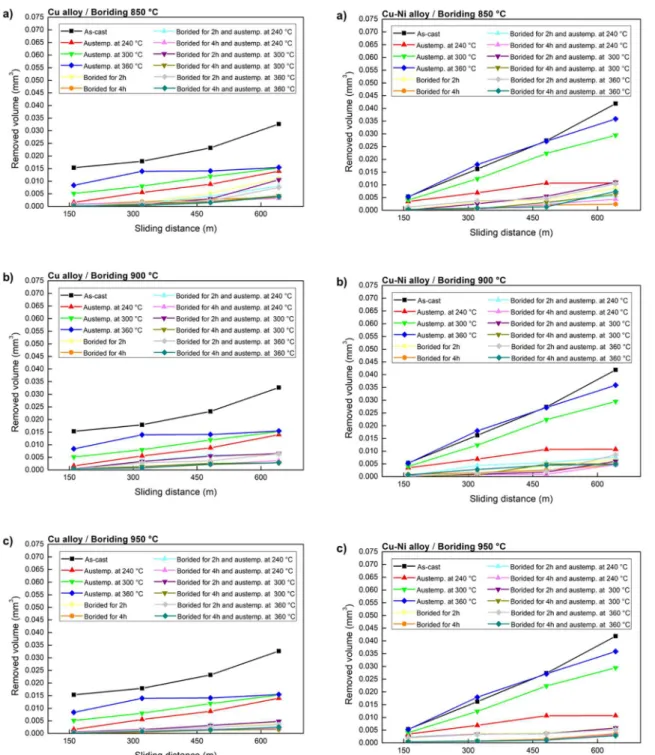Samples of ductile cast irons alloyed with Cu, Cu-Ni and Cu-Ni-Mo were austempered, borided and boro-austempered and characterized for hardness and micro-adhesive wear behavior. The kinetics of layer formation was also studied. The boriding method used was molten borax bath, in periods of 2 and 4 hours at temperatures of 850, 900 and 950 ºC. The direct austempering treatment was performed immediately following the boriding treatment (from 850, 900 and 950 ºC) using molten salt baths at temperatures of 240, 300 and 360 ºC for 4 hours (boro-austempering treatment). For comparative purposes, the conventional austempering treatment was also conducted. Optical microscopy, scanning electron microscopy, Brinell hardness measurements (on the substrate) and Vickers (on the layers) were performed, along with micro-adhesive wear tests. The boriding treatment resulted in the formation of high hardness layers, in the range of 1450 to 1750 HV, with high wear resistance. The wear resistance of borided and boro-austempered samples were increased by 40 times when compared to as cast or austempered samples, indicating the high efficiency of this type of treatment in increasing the wear resistance of this material.
Keywords: ductile cast iron, ADI, boriding, boro-austempered, kinects, micro-adhesive wear test.
*e-mail: mariani.fabioe@gmail.com
1. Introduction
Austempered ductile cast iron (ADI) is an engineered material that exhibits excellent wear resistance and good mechanical properties, foremost among them: high tensile and fatigue strength with good ductility and impact resistance1-5.
During austempering, ferrite plates (α) nucleate and grow in the primary austenite grain (γo), separated by thin layers of high carbon austenite (γHC). As the reaction proceeds, the diffusion of carbon becomes increasingly difficult and ferrite plate growth is stopped. The remaining austenite becomes stable by high levels of carbon and the material can be cooled to room temperature without the formation of martensite. The outcome of such a treatment is a microstructure consisting of retained austenite and acicular ferrite, also called ausferrite. This is known as Stage I. Prolonged times in austempering baths cause the decomposition of the high carbon austenite into ferrite and ε - carbides. The bainitic microstructure is the result of this process, which is known as Stage II, and is detrimental to the mechanical properties of ADIs and should therefore be avoided. Stages I and II can be summarized as follows: Stage I: primary austenite (γo) → ferrite (α) + stable high carbon austenite (γHC) = ausferrite. Stage II: stable high carbon austenite (γHC) → ferrite (α) + ε = carbides + bainite
1-6. The period between the end of the first stage and the start of the second process is called the process window. The ADI process window can be determined by: the concentration
of retained austenite and carbon in primary austenite; or the volume of residual austenite after austempering 7. ADIs have been attracting attention as a substitute for forged steel components for many applications. The industries where this material is used includes: automotive, agricultural, railway, military and construction3-5.
Although austempering increases the wear resistance of ductile cast iron, the application of surface thermochemical treatments provide a significant improvement in wear performance relative to plain austempered material, further extending the application range of these components by increasing the service life and decreasing downtime caused by maintenance. Among these techniques, boriding is one of the methods employed to increase the surface wear resistance with a high hardness (2100 HV) and corrosion resistance layer. The treatment consists in the diffusion of boron atoms into the surface of a substrate to produce a layer of iron boride (FeB and/or Fe2B), and depending on the chemical composition of the material, borides of other chemical elements. By holding the temperature between 800 and 1100 ºC for 1 to 8 hours in the boriding salt bath (borax), a highly promising technique for the surface treatment of ADIs can be acheived, being simple, inexpensive and allowing austempering to be performed directly from the boriding treatment without the need to reheat. The combination of these two treatments is called boro-austempering8-11.
Boro-Austempering Treatment of Ductile Cast Irons
Fábio Edson Mariania* , Carolina Soaresa, Amadeu Lombardi Netob, George Edward Tottenc ,
Luiz Carlos Castelettia
aDepartamento de Engenharia de Materiais, Escola de Engenharia de São Carlos, Universidade de São Paulo, São Carlos, SP, Brasil
bDepartamento de Engenharia Mecânica, Universidade Tecnológica Federal do Paraná, Londrina, PR, Brasil
cDepartment of Materials, Portland State University, Portland, Oregon, USA
The aim of this study was to evaluate the influence of the boriding thermochemical treatment on the hardness of the substrate, the microstructural characterization of the layer produced, to analyze the growth kinetics and to verify the influence of the boriding in the adhesive wear resistance of ductile cast irons with different chemical compositions.
2. Materials and Methods
Austempering, boriding and boro-austempering treatments were applied in perlite matrix ductile cast irons (with addition of elements such as copper, nickel and molybdenum) whose chemical compositions are shown in Table 1, according to ASTM A897 / A897M standard12.
Austempering treatment was performed in salt bath at 240, 300 or 360 ºC during 4 hours, for each of the ductile cast iron compositions followed by air-coolling of the samples. The as-cast samples of ductile cast irons were also used as substrate for liquid boriding, in which the samples were immersed for 2 or 4 hours, at 850, 900 or 950 ºC, in molten borax (sodium borate PA: Na2B4O7) and aluminum (10% by mass) and then air cooled to room temperature (27 ºC).
The boro-austempering and boriding treatments were carried out using similar conditions (bath composition, temperatures and times) always under ambient atmosphere.
The samples were characterized by optical microscopy, scanning electron microscopy (SEM) and X-ray dispersive energy (EDX) spectroscopy in the sample cross sections. X-ray diffraction with copper radiation, Kα (XRD) was also performed to identify the phases present. Two types of hardness tests were used: Brinell in the substrates of the cast irons and Vickers microhardness in the borided layers (loads of 2 N to evaluate the average hardness of the layers and 0.5 N to obtain the microhardness profile). Fifteen measurements were made on each material to obtain the average hardnesses.
The kinetic development of the boride layer was studied by calculating the activation energy for boron diffusion and the diffusion coefficient of the boron in the substrate. The diffusion coefficient was estimated by the slope of the line (through the origin) obtained in the plot of the layer thickness versus the time of treatment. The activation energy was calculated by the Arrehnius equation (Equation 1), in which the diffusion coefficient (K) of each of the boriding temperatures was used. K0 is the pre-exponential constant independent of temperature, Q is the activation energy for diffusion, R is the gas constant (8.31 J/mol-K) and T is the
absolute temperature. Applying the neperian logarithm to Equation 1 gives the Equation 2 and plotting ln (K) as a function of the inverse of the absolute temperature gives a straight line whose slope is Q/R and intercept on the Y axis is ln (K0).
(1)
(2)
The wear resistance of the as-cast, austempered, borided and boro-austempered materials were evaluated by means of microscale adhesive wear tests using fixed ball (calotest type) as described in 13,14. These tests were performed using a SAE 52100 steel spheres 25.4 mm in diameter and 60 HRC hardness, with rotation speed of 400 rpm and a of load of 2.8 N applied to the sample. The tests were carried out for 5, 10, 15 and 20 minutes (equivalent to 160, 320, 480 and 640 m). The mean diameter of the worn caps was measured by optical microscopy and with this value the volume of material removed was calculated using Equation 313-16. The wear tests were carried out at 26 ºC and a relative humidity of 60%, under dry sliding friction (in air and without lubrification), to prevent any interfacial element from causing influences on the effect of microstructural features.
(3)
3. Results and Discussion
Figure 1 shows the scanning electron micrographs of the austempered cast irons samples. The temperature of the austempering treatment showed marked influence on the resulting microstructure with samples treated at 240 ºC producing a large volumetric fraction of fine acicular ferrite with austenite between the needles. However, at 360 ºC microstructures with feathery-type ferrite and with a higher retained austenite content were produced, which is found not only between the needles, but also in the form of blocks. At 300 ºC an intermediate microstructure between the ones at 240 and 360 ºC was produced and their morphology also depended on the alloying elements present. Cast iron with higher content of alloying elements produced coarse microstructures, with a higher fraction of retained austenite, even when austempered at lower temperatures (300 ºC). Similar results were found in7,8,17-20.
Table 1. Chemical composition of ductile cast irons (weight %).
Material C Si Mn Cu Ni Mo Fe
Ductile cast iron – Cu 3.71 2.69 0.22 0.69 - - Balance
Ductile cast iron – Cu-Ni 3.73 2.65 0.22 0.68 1.24 - Balance
Ductile cast iron – Cu-Ni-Mo 3.78 2.56 0.25 0.69 1.69 0.27 Balance
exp
K=Ko
T
RTQY
lnK=lnKo RQ
S X
T1V 64dR para d<<R
4 r
The formation of acicular ferrite starts at the austenitic grain boundary, by the segregation of carbon and as the austempering temperature decreases the resulting microstructure becomes more refined, since the supercooling is larger and the diffusion rate of carbon decreases. In other words, the nucleation of ferrite cores is favored rather than their growth. At higher temperatures the diffusion of carbon is facilitated, in this way grain growth is favored, forming coarser microstructures 7,8,17-20. The presence of alloying elements such as copper,
nickel and molybdenum retard the end of the ausferrite transformation, allowing more time for grain growth, thus the higher the content of these elements (combined or not), the greater the tendency to form coarse microstructures, even at lower temperatures 7.
Figure 2 shows the cross-sectional photomicrograph of the boride layer of a copper alloyed ductile cast iron sample borided at 850 ºC for 4 hours. The iron boride layer, which includes graphite nodules and the pearlitic microstructure of the substrate, is verified.
Figure 1. Scanning electron micrographs of ADI: alloyed with Cu austempered at (a.1) 240, (b.1) 300 e (c.1) 360 ºC; Alloyed with Cu and Ni austempered at (a.2) 240, (b.2) 300 and (c.2) 360 ºC; Alloyed with Cu, Ni and Mo austempered at (a.3) 240, (b.3) 300 and (c.3) 360 ºC. The arrows indicate the regions in which the retained austenite appears in blocks. Etching: Nital 3%
Figure 2. Cross section of ductile cast iron alloyed with Cu, borided at 850 ºC for 4 hours and air cooled. Etching: Nital 2%
The phases composing the layers were identified by X-ray diffraction, as shown in Figure 4 using the datasheets ICSD-391329 for the FeB phase and ICSD-391328 for the Fe2B phase. The copper alloyed ductile cast iron sample showed only the Fe2B phase, composed of 8.83% boron, with a centered body tetragonal arrangement, a modulus of elasticity between 285 and 295 GPa and density of 7.43 g/cm3. However, the substrates of ductile cast iron alloyed with copper- nickel or copper-nickel-molybdenum also showed the FeB phase, rich in boron (16.3% by weight), orthorhombic crystal structure, elastic modulus of 590 GPa and density of 6.75 g/cm39,10,21. The FeB phase presents a higher hardness but lower toughness, and its formation occurs under tensile stresses (contrary to Fe2B formation that occurs under compressive stresses) what commonly give rise to cracks that propagate at its interface22-25.
Figure 4. DRX of the layers on the substrates: a) ductile cast iron alloyed with copper, b) ductile cast iron alloyed with copper and nickel and c) ductile cast iron alloyed with copper, nickel and molybdenum. The Boriding treatment was carried out at 950 ºC for 4 hours
Since boriding is a thermochemical surface treatment the layer thickness is influenced by the temperature and time of treatment, as shown in Figure 5. As the growth of the layer occurs by diffusion, the increase in the treatment time leads to the formation of thicker layers, as does the increase in temperature, which raises the diffusion coefficient of the boron in substrate.
Figure 5. Thickness of the boride layers as a function of the treatment
temperature for different substrates, borided for 2 or 4 hours
Figure 6. Brinell hardness for each substrate and different temperatures It is observed that the samples of copper and copper-nickel alloyed ductile cast iron presented layers with similar thicknesses for the same treatment conditions, and therefore, the addition of nickel to cast iron did not influence the growth of the layer. However, the addition of molybdenum retarded its growth, a phenomenon associated with the formation of a barrier that limits the diffusion of boron to the substrate. Other studies have shown the same effect in alloys with different chemical compositions9,26.
Figure 7 shows the hardness values of the layers produced by boriding and boro-austempering treatment, varying the treatment time, temperature and substrate. It is verified that for both treatments, boriding and boro-austempering, coatings of high hardness were produced. The increase in the treatment time resulted in an increase in the hardness of the layers. The highest thermochemical treatment temperature
Figure 7. Hardness of borided and boro-austempered layers as a function of the boriding temperature for ductile cast iron substrates: a.1) Cu borided for 2 hours, a.2) Cu borided for 4 hours, b.1) Cu-Ni borided for 2 hours, b.2) Cu-Ni borided for 4 hours, c.1) Cu-Ni-Mo borided for 2 hours and c.2) Cu-Ni-Mo borided for 4 hours
Figure 8 shows a Vickers microhardness profile for a ductile cast iron alloyed with Cu borided at 900 ºC for 2 hours and austempered at 360 ºC for 4 hours.
It is noted that the hardness of the layer near the surface is about 1670 HV, decreasing towards the substrate. The hardness obtained at the interface was 1000 HV, much lower than those obtained in the boron layer. The hardness of the substrate was approximately 450 HV. All borided and boro-austempered samples showed similar behavior in the microhardness profile.
Figure 8. Vickers hardness profile (load 0,5 N) in a ductile cast iron alloyed with Cu borided at 900 ºC for 2 hours and austempered at 360 ºC. Etching: Nital 2%
The plots of the squared layer thickness as a function of the boriding time, for each of the temperatures, are shown in Figure 9, with the slope of the lines being the diffusion coefficient (m2s-1). The diffusion coefficient of boron increases with the temperature as shown in the image. In the substrates of ductile cast iron alloyed with copper or copper- nickel there is no variation of the diffusion coefficient, and therefore the nickel does not influence the diffusion of this element. However, the presence of molybdenum affects its diffusion, especially at the lower boriding temperatures (850 or 900 ºC).
Figure 10 shows the plot of the diffusion coefficient (ln) as a function of the inverse of the absolute temperature for all substrates. From this graph the pre-exponential constant and activation energy were calculated, and the results are presented in Table 2. The substrate with molybdenum presented the highest activation energy for boron diffusion, thus, the formation of boron layers on this substrate requires more energy. The consequence is shown in Figure 5, where finer layers are formed for this substrate at temperatures of 850 and 900 ºC.
The inner surface of the borided layer wear caps on the samples of copper and nickel alloyed cast irons in the untreated and austempered conditions at 240, 300 and 360 ºC, after 20 min of test (sliding distance of 640 m) under dry friction condition is shown in Figure 11.
Figure 9. Plot of the layer thickness as a function of the boriding time for the ductile cast iron substrates alloyed with a) Cu and Cu-Ni, b) Cu-Ni-Mo. The values of its slope are indicated on the curves
Figure 10. Plots for determination of activation energy for ductile cast iron samples alloyed with Cu and Cu-Ni
Table 2. Results of the activation energy for ductile cast iron borided samples alloyed with Cu, Cu-Ni and Cu-Ni-Mo.
Ductile Iron K0 (m2s-1) Q (kJmol-1)
Cu and Cu-Ni 1.81x10-7 121
Figure 11. Aspect of the interior of the wear caps. Traveled distance: 640 m (20 min). (a) Cast iron alloyed with Cu-Ni, (b) Cu-Ni ADI austempered at 240 ºC, (c) Cu-Ni ADI austempered at 300 ºC and (d) Cu-Ni ADI austempered at 360 ºC
For the three cast iron samples in the as-cast and austempered conditions, the wear surface indicated two active wear mechanisms. The first type of abrasion is two bodies, with the presence of characteristic scratches. The second mechanism observed is the adhesive, represented by the transfered metal films. The same characteristics were observed for other test times.
In Figure 12 the micrograph of the wear cap inner surface for 20 min. testing time is shown for the ductile cast iron alloyed with Cu, borided for 2 hours and air cooled. It is verified the presence of transfered metal films, characteristic of the adhesive wear. The same was observed for the other testing times. For all borided or boro-austempered samples, the active wear mechanism observed was adhesive type.
Figures 13 to 15 shows the micro-adhesive wear tests plots for ductile cast iron substrates alloyed with copper, copper-nickel and copper-nickel-molybdenum, under the as-cast, austempered, borided and boro-austempered conditions.
The samples in the as-cast condition presented the least wear resistance for all studied ductile cast irons.
Austempering treatments produced a marked increase in the wear resistance of the alloys, due to the increase in hardness provided by the ausferritic matrix in comparison with the perlitic matrix present in the as-cast condition. The alloys austempered at the lowest temperature (240 ºC) presented the best performance, due to its higher hardness resulting from its more refined microstructure, with increased amounts of the harder acicular ferrite when
Figure 12. Aspect of the wear cap inner surface after 20 min. testing time in the ductile cast iron sample borided for 2 hours and air cooled. Sliding distance: 640 m
compered with the softer retained austenite, present in lower quantites.
Figure 13. Micro-adhesive wear plots for ductile cast iron samples alloyed with Cu in all conditions. Thermochemical treatment performed at a) 850, b) 900 and c) 950 ºC
Figure 15. Micro-adhesive wear plots for ductile cast iron samples alloyed with Cu-Ni-Mo in all conditions. Thermochemical treatment performed at a) 850, b) 900 and c) 950 ºC
4. Conclusions
The activation energy calculated for ductile cast iron alloyed with Cu and Cu-Ni (121 kJmol-1) is less than the activation energy for the iron alloyed with Cu-Ni-Mo (188 kJmol-1). Therefore, the addition of Mo to ductile cast iron delayed the formation of the layer once that higher activation energy was required for the coating to be formed.
Austenitic isothermal treatments significantly increased (up to 4 times) the wear resistance of the ductile irons, and for the three compositions studied the ADI austempered at 240 ºC presented the best performances, followed by the ADIs treated at 300 and 360 ºC.
The boro-austempering treatments were highly effective in increasing the adhesive wear resistance of the samples. For the three materials analyzed, the higher temperatures and times of the thermochemical treatment resulted in the best wear performances.
The boro-austempering treatment provided layers with similar characteristics to the layers obtained with boriding followed by air cooling, indicating the feasibility of this treatment.
Increases in the hardness of coatings obtained with higher treatment times were observed, which may be associated to the increase of FeB content in the boride layer, with consequent increase in hardness and wear resistance.
The Cu-Ni and Cu-Ni-Mo cast iron samples borided layers showed the best wear behavior, with the latter exhibiting exceptional performance, followed by Cu-Ni. This may be associated with the higher FeB content in the layers. The wear resistance of ductile cast iron samples alloyed with Cu-Ni-Mo either borided or boro-austempered were increased by up to 40x in relation to the as cast or the austempered samples.
The marked increase in the wear resistance provided by the boriding or boro-austempering treatments in ductile cast irons indicates the possibility of expanding the application range of these alloys, increasing the service life of parts and components and reducing maintenance costs.
5. References
1. Hsu CH, Lu JK, Tsai RJ. Characteristics of duplex surface
coatings on austempered ductile iron substrates. Surface and Coatings Technology. 2006;200(20-21):5725-5732.
2. Rao PP, Putatunda SK. Investigations on the fracture toughness of austempered ductile irons austenitized at different temperatures.
Materials Science and Engineering: A. 2003;349(1-2):136-149.
3. Putatunda SK, Ambooken MT, Pullum BJ. Thermo-magnetic
processing of ductile cast iron. Materials Science and Engineering: A. 2007;460-461:31-38.
4. Yang J, Putatunda SK. Influence of a novel two-step austempering
process on the strain-hardening behavior of austempered ductile cast iron (ADI). Materials Science and Engineering: A. 2004;382(1-2):265-279.
5. Putatunda SK, Kesani S, Tackett R, Lawes G. Development of
austenite free ADI (austempered ductile cast iron). Materials Science and Engineering: A. 2006;435-436:112-122.
6. Kazemi M, Kiani-Rashid AR, Nourian A, Babakhania A.
Investigation of microstructural and mechanical properties of austempered steel bar-reinforced ductile cast iron composite. Materials & Design. 2014;53:1047-1051.
8. Kayali Y, Yalçin Y. The effects of boro-tempering heat treatment
on microstructural properties of ductile iron. Materials & Design. 2011;32(3):1414-1419.
9. ASM International. ASM Handbook. Volume 4. Heat Treating. Materials Park: ASM International; 1991.
10. Wang QJ, Chung YW, eds. Encyclopedia of Tribology. Volume 1. 1st ed. New York: Springer; 2013.
11. Sen U, Sen S, Yilmaz F. Effect of copper on boride layer of
boronized ductile cast irons. Vacuum. 2003;72(2):199-204.
12. ASTM International. ASTM A897/A897M-06 - Standard
specification for austempered ductile iron castings. West
Conshohocken: ASTM International; 2006.
13. Oliveira CKN, Muñoz Riofano RM, Casteletti LC.
Micro-abrasive wear test of niobium carbide layers produced on AISI H13 and M2 steels. Surface and Coatings Technology. 2006;200(16-17):5140-5144.
14. Oliveira CKN, Benassi CL, Casteletti LC. Evaluation of hard
coatings obtained on AISI D2 steel by thermo-reactive deposition treatment. Surface and Coatings Technology. 2006;201(3-4):1880-1885.
15. Rutherford K, Hutchings I. Theory and Application of a
Micro-Scale Abrasive Wear Test. Journal of Testing and Evaluation. 1997;25(2):250-260.
16. Rutherford KL, Hutchings IM. A micro-abrasive wear test, with
particular application to coated systems. Surface and Coatings Technology. 1996;79(1-3):231-239.
17. Eric O, Rajnovic D, Zec S, Sidjanin L, Jovanovic MT. Microstructure and fracture of alloyed austempered ductile iron. Materials Characterization. 2006;57(4-5):211-217.
18. Eric O, Sidjanin L, Miscovic Z, Zec S, Jovanovic MT. Microstructure and toughness of CuNiMo austempered ductile iron. Materials Letters. 2004;58(22-23):2707-2711.
19. Aranzabal J, Gutierrez I, Rodriguez-Ibabe JM, Urcola JJ.
Influence of the amount and morphology of retained austenite
on the mechanical properties of an austempered ductile iron. Metallurgical and Materials Transactions A. 1997;28(5):1143-1156.
20. Zahiri SH, Davies CHJ, Pereloma EV. Simultaneous prediction of austemperability and processing window for austempered ductile iron. Materials Science and Technology. 2003;19(12):1761-1770.
21. Martini C, Palombarini G, Carbucicchio M. Mechanism of thermochemical growth of iron borides on iron. Journal of Materials Science. 2004;39(3):933-937.
22. Kapfenberger C, Albert A, Pöttgen R, Huppertz H. Structure
refinements of iron borides Fe2B and FeB. Zeitschrift für
Kristallographie-Crystalline Material. 2006;221(5-7):477-481.
23. Sen U, Sen S, Koksal S, Yilmaz F. Fracture toughness of
borides formed on boronized ductile iron. Materials & Design. 2005;26(2):175-179.
24. Sen U, Saduman S. The fracture toughness of borides formed on boronized cold work tool steels. Materials Characterization. 2003;50(4-5):261-267.
25. Ozbek I, Bindal C. Mechanical properties of boronized AISI W4 steel. Surface and Coatings Technology. 2002;154(1):14-20.
26. Stewart K. Boronizing protects metals against wear. Advanced


